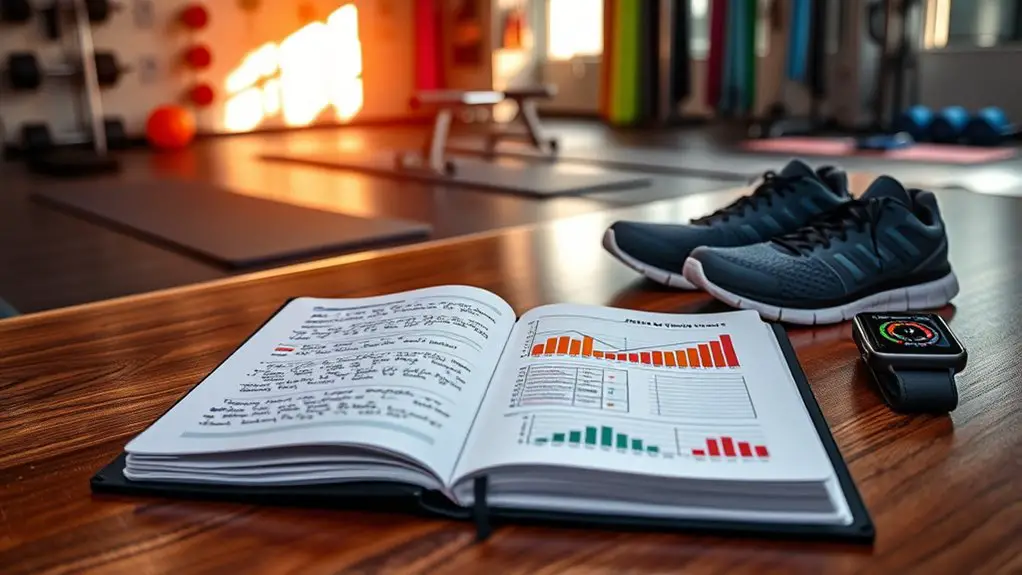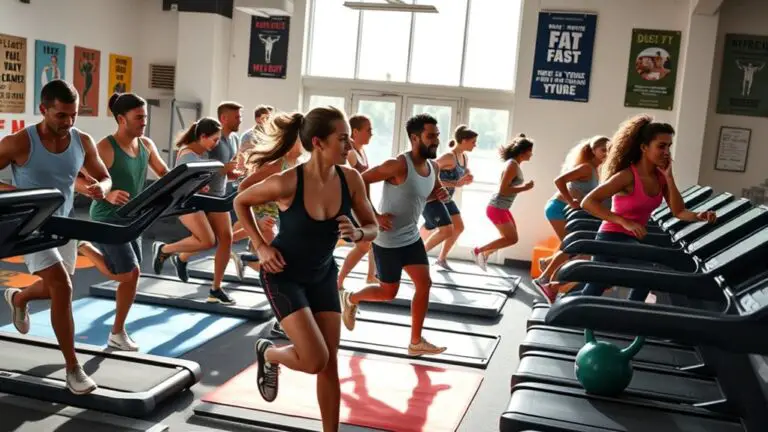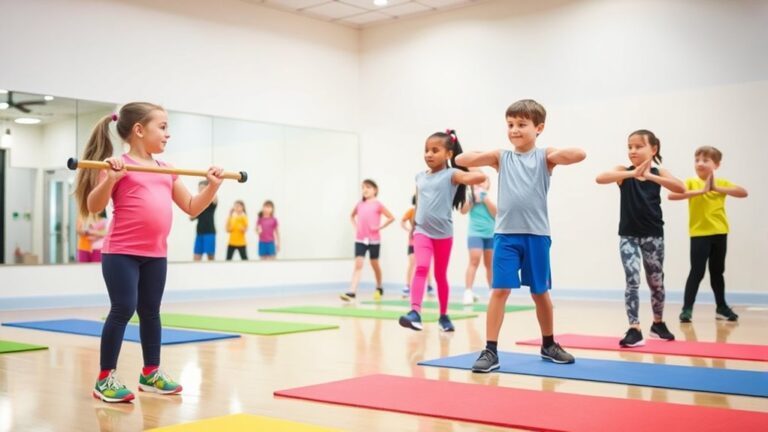How to Build a Gym Routine That Works

To build a gym routine that works, start by evaluating your current fitness level and defining clear goals using the SMART criteria. Choose a mix of strength training and cardio exercises to guarantee a balanced approach. Create a weekly workout schedule that includes rest and recovery days to prevent burnout. Track your progress to stay motivated and adjust your routine as needed. Stick around for more tips on tailoring your workout for ideal results!
Assess Your Current Fitness Level

How well do you know your current fitness level? Understanding where you stand is essential for a safe and effective gym routine. Start with fitness assessments to evaluate your strength, endurance, flexibility, and body composition. These assessments give you valuable health indicators, helping you identify areas for improvement.
You might consider simple tests like timed runs, push-up counts, or flexibility stretches. Remember, it’s important to perform these assessments correctly to avoid injury. If you’re unsure, seek guidance from a fitness professional.
Keep in mind that your fitness level isn’t just about numbers; it can reflect your overall well-being. Regularly revisiting these assessments can help track your progress and adapt your routine accordingly. By knowing your current fitness level, you can set realistic and achievable goals while ensuring you prioritize your safety and health on your fitness journey.
Define Your Fitness Goals
To create an effective gym routine, you need to define your fitness goals clearly. Think about what you want to achieve—whether it’s building strength, losing weight, or improving endurance. By identifying specific objectives, you’ll set a solid foundation for your workout plan. Additionally, tracking signs of progress can help you stay motivated and adjust your routine as needed.
Identify Specific Objectives
What do you want to achieve with your fitness journey? Identifying specific objectives is vital in crafting a routine that works for you. Start by using the SMART criteria: make your goals Specific, Measurable, Achievable, Relevant, and Time-bound. For instance, instead of saying you want to “get fit,” aim for “losing 10 pounds in three months.” Reflect on your personal motivations, whether it’s improving your health, boosting confidence, or enhancing performance. By setting clear and realistic objectives, you’ll create a focused path that keeps you safe and motivated. Remember, breaking down larger goals into smaller, manageable steps can help you track progress and maintain enthusiasm. Your fitness journey should align with what truly matters to you.
Assess Current Fitness Level
Understanding your current fitness level is essential for setting realistic and effective goals. Start with fitness assessments to gauge where you stand regarding strength, endurance, flexibility, and body composition. This helps you identify your strengths and areas for improvement. Take baseline measurements, like your weight, body measurements, and how many push-ups or sit-ups you can do. These figures will serve as a reference point as you progress. Remember, it’s vital to listen to your body and avoid pushing yourself too hard, especially if you’re new to exercise. By having a clear understanding of your starting point, you can create a safe and tailored gym routine that aligns with your personal fitness goals.
Choose the Right Types of Exercise

Choosing the right types of exercise can greatly impact your gym routine, especially if you want to achieve specific fitness goals. Start by incorporating strength training to build muscle and increase metabolism. If you enjoy cardio exercises, consider mixing high-intensity intervals with low-impact options like cycling or swimming to minimize injury risks. Flexibility routines, such as yoga or stretching, are essential for maintaining mobility and preventing soreness.
Functional fitness exercises mimic everyday movements, making them practical for daily life. You might prefer group classes for motivation and social interaction, or choose solo workouts for flexibility in your schedule. Don’t forget about outdoor activities like hiking or running, which can add variety to your routine while keeping it fun. Skipping rope provides a great cardio workout that helps burn calories effectively, making it a beneficial addition to your regimen. Balance indoor exercises with outdoor options to keep your routine engaging and safe. Prioritize what feels right for your body, and your fitness journey will be rewarding!
Create a Weekly Workout Schedule
Creating a weekly workout schedule is essential for staying on track with your fitness goals. You’ll need to determine how often you can realistically work out, plan rest days to allow your body to recover, and mix different types of exercises to keep things interesting. Let’s break down how to structure your week for maximum effectiveness. Incorporating activities like jump rope can provide a fun and effective way to enhance your cardiovascular fitness.
Determine Workout Frequency
When it comes to building a gym routine, figuring out how often you’ll work out each week is vital. Establishing your workout frequency not only helps with workout consistency but also maximizes frequency benefits, like improved strength and endurance. For beginners, aim for three to four sessions weekly, focusing on different muscle groups to avoid overtraining. If you’re more experienced, you might increase this to five or six days, integrating a mix of cardio and strength training. Listen to your body; if you feel fatigued or sore, it’s important to adjust your schedule. Prioritizing a sustainable routine guarantees you stay committed while minimizing injury risks, ultimately leading to better long-term results.
Schedule Rest Days
While it’s essential to fill your week with workouts, scheduling rest days is equally important for recovery and overall progress. Ignoring the rest day importance can lead to fatigue, increased risk of injury, and burnout. Giving your body time to recover helps muscles repair and grow stronger, ultimately enhancing your performance.
Consider incorporating active recovery on rest days, like light walking, yoga, or stretching. These activities keep your blood flowing and help alleviate soreness without putting too much strain on your body. Aim for at least one or two rest days each week, depending on your workout intensity. Listen to your body; if you feel worn out, don’t hesitate to adjust your schedule. Prioritizing rest will set you up for long-term success.
Mix Workout Types
To maximize your fitness gains, mixing different workout types throughout the week is essential. This not only prevents boredom but also helps in building a well-rounded fitness level while ensuring safety. Here’s a simple weekly schedule to get you started:
- Circuit Training: Engage in high-intensity exercises that target multiple muscle groups.
- Cardio: Incorporate at least 150 minutes of moderate-intensity cardio for heart health.
- Strength Training: Focus on building muscle with weights or resistance bands, twice a week.
- Flexibility and Recovery: Finish the week with yoga or stretching to maintain flexibility and prevent injuries.
Incorporate Rest and Recovery
Incorporating rest and recovery into your gym routine is essential for maximizing your results and preventing injury. Without adequate recovery, your muscles can become fatigued and overworked, leading to burnout or injury. Be sure to schedule at least one or two rest days each week, allowing your body to heal and recharge.
Active recovery is a great way to stay engaged while giving your muscles a break. Consider light activities like walking, yoga, or swimming on these days. These gentle movements can promote blood flow and aid in muscle repair.
Additionally, don’t overlook essential recovery techniques such as stretching, foam rolling, and proper hydration. These practices can help alleviate soreness and improve flexibility. Remember, it’s not just about how hard you train, but how well you recover that contributes to your overall fitness journey. Prioritize your recovery to achieve long-lasting results safely.
Track Your Progress

Tracking your progress is essential for staying motivated and guaranteeing you’re on the right path toward your fitness goals. By implementing effective progress tracking, you can identify your fitness benchmarks and make informed adjustments to your routine. Here are four ways to track your progress safely:
- Keep a Workout Journal: Record your exercises, sets, and reps to visualize improvements over time.
- Use Fitness Apps: Many apps allow you to log workouts, monitor your performance, and set reminders.
- Take Photos: Capture your physical changes over weeks or months to see how far you’ve come.
- Measure Your Body: Regularly check your weight, body fat percentage, and measurements to gauge your progress.
Incorporating activities like skipping can enhance your cardiovascular fitness and boost energy levels, which can be beneficial to track as part of your routine.
These methods not only help you stay accountable but also guarantee that you’re progressing safely, avoiding injury while working toward your fitness benchmarks.
Stay Motivated and Adjust as Needed
While sticking to a gym routine can be challenging, finding ways to stay motivated is essential for long-term success. Start by setting realistic goals that inspire you. Break them down into smaller, achievable milestones, and celebrate each accomplishment. This fosters a sense of achievement that boosts your motivation.
Incorporate motivation strategies that keep your workouts fresh and engaging. Try varying your exercises, joining a class, or working out with a friend to maintain enthusiasm. Don’t hesitate to adjust your routine based on your progress and how your body feels. If something isn’t working or causes discomfort, it’s okay to switch it up.
Additionally, it’s important to acknowledge the need for rest days to avoid burnout and maintain your enthusiasm for workouts. Listen to your body and prioritize safety. Remember, consistency is key, but so is being adaptable. By staying focused on your goals while embracing flexibility, you’ll cultivate a sustainable gym routine that supports both your physical health and mental well-being.
Frequently Asked Questions
How Do I Choose the Right Gym Membership for My Needs?
Choosing the right gym membership can feel like searching for a needle in a haystack, but it doesn’t have to be overwhelming! Start by considering membership types that suit your lifestyle, whether you prefer a no-frills option or a luxury experience. Look at the gym amenities too—do they have safe equipment, spacious areas, and cleanliness? You want a place where you feel comfortable and secure while working towards your fitness goals.
Should I Hire a Personal Trainer or Go Solo?
When deciding whether to hire a personal trainer or go solo, consider the benefits comparison. A trainer provides personalized guidance tailored to your goals and training styles, ensuring you stay safe and effective. However, going solo can save you money, which is important in a cost analysis. Think about your personal goals and how much motivation you need. If you’re unsure, a trainer might help kickstart your fitness journey safely.
What Should I Wear to the Gym for Comfort?
Picture yourself stepping onto the gym floor, feeling confident in breathable fitness fabrics that wick away sweat. You’ll want a fitted top and supportive bottoms that allow for easy movement. Don’t forget about shoe selection—choose sneakers that offer stability and grip, ensuring your feet are cushioned and protected. Comfort is key, but safety’s just as important; avoid loose clothing that could snag on equipment. Dress right, and you’ll feel ready to tackle your workout!
How Do I Deal With Gym Intimidation?
Dealing with gym intimidation can feel overwhelming, but you’re not alone. Start by recognizing that everyone’s there to improve themselves, just like you. Overcoming anxiety takes time, so try visiting during off-peak hours when it’s quieter. Focus on small goals, like mastering a few exercises, to help build your confidence. Remember, it’s okay to ask for help or guidance; most people are supportive and understanding. You’ve got this!
What Should I Eat Before and After Workouts?
Did you know that 30% of gym-goers skip pre and post workout meals, which can hinder their performance? To fuel your workouts effectively, consider having a light snack like a banana or a yogurt 30 minutes before you hit the gym. After your workout, focus on a balanced meal with protein and carbs, like grilled chicken and quinoa, to help with recovery. Eating right guarantees you feel energized and safe during your fitness journey.





